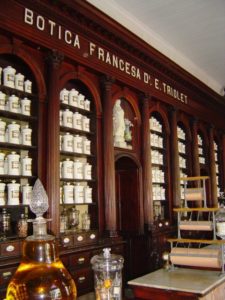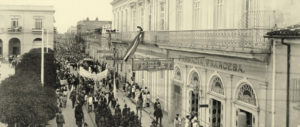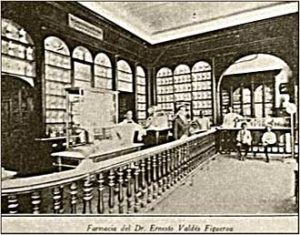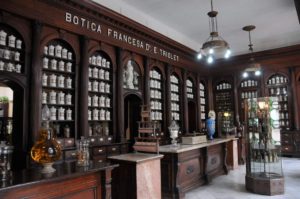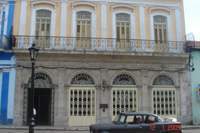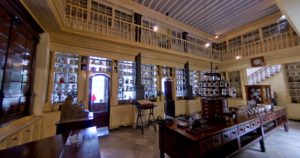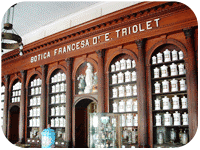MATANZAS CONSERVA LA PRIMERA BOTICA FRANCESA DEL MUNDO DE LOS AÑOS 1800S.
Museo Farmacéutico de Matanzas. Localizado en la ciudad de Matanzas y edificado para botica e inaugurado en 1882 y realizó esta función hasta el 16 de enero de 1964 en que es nacionalizada por el gobierno actual.
El Museo conserva la atmósfera de esta botica del siglo XIX, gracias a que aún permanecen sus estanterías originales, frascos, utensilios, libros e instrumentos en el mismo lugar escogido por sus fundadores hace más de 100 años.
Reabre sus puertas como el primer museo farmacéutico de Latinoamérica. En su construcción predominó el eclecticismo, una escuela filosófica que se caracteriza por escoger concepciones filosóficas, puntos de vista, ideas y valoraciones entre las demás escuelas que sean compatibles de forma coherente, combinándolas y mezclándolas.
Actualmente, conserva todos los elementos muebles e inmuebles originales y es la única botica francesa de finales del Siglo XIX que permanece en el mundo.
Su Historia.
El Dr.Triolet Lelievre, de origen francés, obtiene el título de Doctor en Farmacia en 1860 y revalida su título en la Universidad de la Habana el 10 de enero de 1866, después de llegar a la Isla gracias a una invitación que le hiciera el doctor Juan Fermín de Figueroa, entonces Rey de Boticas de Cuba, a quien había conocido en París. A su llegada a Cuba, fundan una Botica Francesa en Sagua la Grande Nuestra Señora de Regla. Interesado por el desarrollo social y económico de la Atenas de Cuba, tras su visita en 1880, decidieron edificar una botica al estilo francés, teniendo en consideración sus gustos y características personales.
El inmueble resulta un fiel exponente de la arquitectura neoclásica doméstica de fines del siglo XIX. Consta de dos plantas y otra parcial en el nivel de la azotea, toda alrededor de un patio central.
Durante 82 años el establecimiento ganó fama y clientela por la calidad de sus productos. En 1900, tras la muerte de Triolet, la dirección técnica quedó en manos de Dolores, la esposa, quien mantuvo las características de la Botica y el mismo profesionalismo de sus fundadores.
El 23 de noviembre de 1963 se ‘nacionaliza’ la Botica, cerrandola.
Hoy se distingue en el Museo Farmacéutico sus colecciones, estando entre las más importantes la de los libros de asentamiento de recetas. En ellos se aprecian prescripciones hechas por ilustres galenos matanceros como Font, Madan, Verdugo, Carnot, Saavedra, Abascal y Betancourt, entre otros. También se conservan productos naturales usados en la botica para elaborar los medicamentos, una muy numerosa colección de albarelos de porcelana francesa, así como frascos de cristal de factura norteamericana de diferentes colores. Se aprecia intacto su laboratorio en el que se destacan alambiques, percoradores, lixibiadores, etc.
Aun se conservan toda la estantería original de la botica, así como cientos de miles de etiquetas de cristal y papel empleadas para rotular los productos medicamentosos. La planta alta de vivienda de la familia Triolet-Figueroa, así como sus laboratorios privados fueron permitidos ser usados por ellos. Sus salas de exposición permanente corresponden a lo que antaño fueran la botica, antigua área de venta, rebotica, 2 almacenes, patio, laboratorio y el zaguán.
Sus estantes en su mayoría son de color blanco sobre el que aparecen bellos diseños, muchos hechos a mano, con frecuencia policromados, pero en los que siempre se lee el nombre de lo que contenían, por ejemplo, Lúpulo, Raíz de Belladona, Triaca Magua, Hojas de Acónito, Laca Amarilla, Copal o Anís Estrellado. Suman cientos los tipos de medicamentos que se elaboraron en la Farmacia Francesa y que hoy se conservan en el Museo Farmacéutico.
La parte superior está hecha de dos piezas de jocuma amarilla, mide 5.51 metros de largo, 1.02 metros de ancho y 0.95 metros de altura; posee porta frascos y porta etiquetas giratorios y está rodeada de 32 gavetas y un guarda-aserrín, abridor y portallaves, así como dos tablas auxiliares usadas para la preparación de medicamentos. Sobre su superficie, y con fines expositivos, pueden observarse moldes para elaborar supositorios, óvulos vaginales y obleas, así como capas graduadas, pildoreros, prensa corchos, mechero y hermosos y blanquísimos morteros de mármol de diferentes tamaños.
En la fachada del Museo Farmacéutico de Matanzas, cuelga el Farol de la Guardia, que cada lunes, ininterrumpidamente desde 1882, ilumina la ventana de la guardia.
El Dr. Ernesto Triolet Figueroa, ya viejo y cansado pero con el orgullo de haber creado todo un mundo nuevo declaró meses antes de morir… “esta Botica constituye el ideal de mi vida, puesto que en ella nací y dentro de ella me crié. Me consagré a mantenerla en el orden moral y profesional con el nombre y prestigio de la familia Triolet. No salgo de ella y cuando muera me iré confiado de que alguien la seguirá cuidando” hasta el año 1979 en que ocurre su desaparición física.
MATANZAS PRESERVES THE FIRST FRENCH BOTIC OF THE WORLD OF 1800s.
Pharmaceutical Museum of Matanzas. Located in the city of Matanzas and built for drugstore and inaugurated in 1882 and performed this function until January 16, 1964 when it is nationalized by the current government.
The museum preserves the atmosphere of this nineteenth century pharmacy, thanks to its original shelves, jars, utensils, books and instruments still in the same place chosen by its founders more than 100 years ago.
It reopens its doors as the first pharmaceutical museum in Latin America. In its construction predominated the eclecticism, a philosophical school that is characterized to choose philosophical conceptions, points of view, ideas and evaluations between the other schools that are coherently compatible, combining and mixing them.
At the moment, it conserves all the movable and original elements and it is the unique French pharmacy of end of Century XIX that remains in the world.
History.
El Dr.Ernesto Triolet Lelievre, of French origin, obtained the title of PhD in Pharmacy in 1860 and revalidated his title at the University of Havana on January 10, 1866, after arriving at the Island thanks to an invitation from him. Dr. Juan Fermín de Figueroa, then King of Boticas de Cuba, whom he had met in Paris. Upon their arrival in Cuba, they founded a French Botica in Sagua la Grande Nuestra Señora de Regla. Interested in the social and economic development of the Athens of Cuba, after his visit in 1880, decided to build a French-style pharmacy, taking into consideration their personal tastes and characteristics.
The building is a faithful exponent of the neoclassical domestic architecture of the late nineteenth century. It consists of two floors and another partial on the level of the roof, all around a central courtyard.
For 82 years the establishment gained fame and clientele for the quality of its products. In 1900, after the death of Triolet, the technical direction was left to Dolores, the wife, who maintained the characteristics of the Botica and the same professionalism of its founders.
On November 23, 1963, the Botica was ‘nationalized’, closing it.
Today the Pharmaceutical Museum distinguishes its collections, being among the most important the one of the books of settlement of prescriptions. In them are prescriptions made by illustrious matanceros galenos like Font, Madan, Verdugo, Carnot, Saavedra, Abascal and Betancourt, among others. Also conserved natural products used in the drugstore to make medicines, a very large collection of French porcelain window coverings, as well as glass jars of American invoice of different colors. You can see its laboratory intact, in which stills, percussors, lixibiadores, etc. are highlighted.
The entire original pharmacy shelf is preserved, as well as hundreds of thousands of glass and paper labels used to label medical products. The upper floor of the Triolet-Figueroa family, as well as their private laboratories were allowed to be used by them. Its permanent exhibition rooms correspond to what used to be the apothecary, old sales area, rebotica, 2 warehouses, patio, laboratory and the hall.
Their shelves are mostly white in color with beautiful designs, many handmade, often polychrome, but always read the name of what they contained, for example, Hops, Belladonna Root, Triaca Magua , Aconite Leaves, Yellow Lacquer, Copal or Star Anise. There are hundreds of types of drugs that were made in the French Pharmacy and are preserved today in the Pharmaceutical Museum.
The upper part is made of two pieces of yellow jocuma, measuring 5.51 meters long, 1.02 meters wide and 0.95 meters high; It has portafrascos and porta revolving labels and is surrounded by 32 drawers and a sawdust, opener and portallaves, as well as two auxiliary tables used for the preparation of medicines. On its surface, and for exhibition purposes, molds can be observed to make suppositories, vaginal ova and wafers, as well as graduated layers, pellets, corks, lighters and beautiful white marble mortars of different sizes.
On the façade of the Pharmaceutical Museum of Matanzas hangs the Lantern Lighthouse, which every Monday, uninterruptedly since 1882, illuminates the window of the guard.
Dr. Ernesto Triolet Figueroa, already old and tired but with the pride of having created a whole new world declared months before he died … “this Botica constitutes the ideal of my life, since in her I was born and in her I devoted myself to maintaining it in the moral and professional order with the name and prestige of the Triolet family.I do not leave it and when I die I will be confident that someone will continue to care for it “until the year 1979 when his physical disappearance
Agencies/Wiki/EcuRed/Various/Internet Photos/Arnoldo Varona/TheCubanHistory.com
THE CUBAN HISTORY, HOLLYWOOD.



 MATANZAS PRESERVES the First French Botic of the World of the 1800s. + MATANZAS CONSERVA la Primera Botica Francesa del Mundo de los años 1800s.
MATANZAS PRESERVES the First French Botic of the World of the 1800s. + MATANZAS CONSERVA la Primera Botica Francesa del Mundo de los años 1800s.